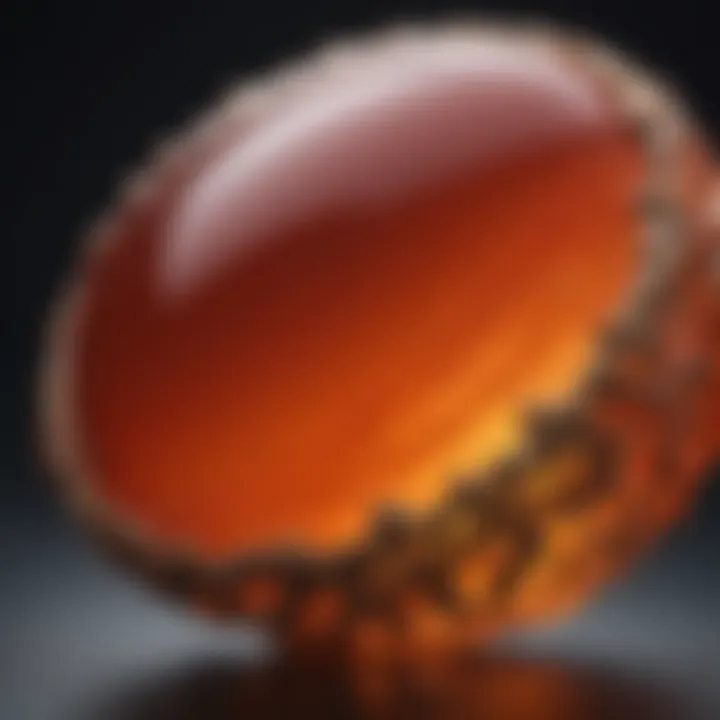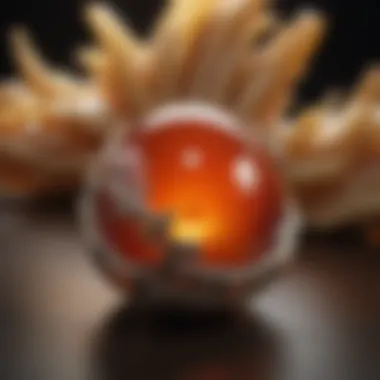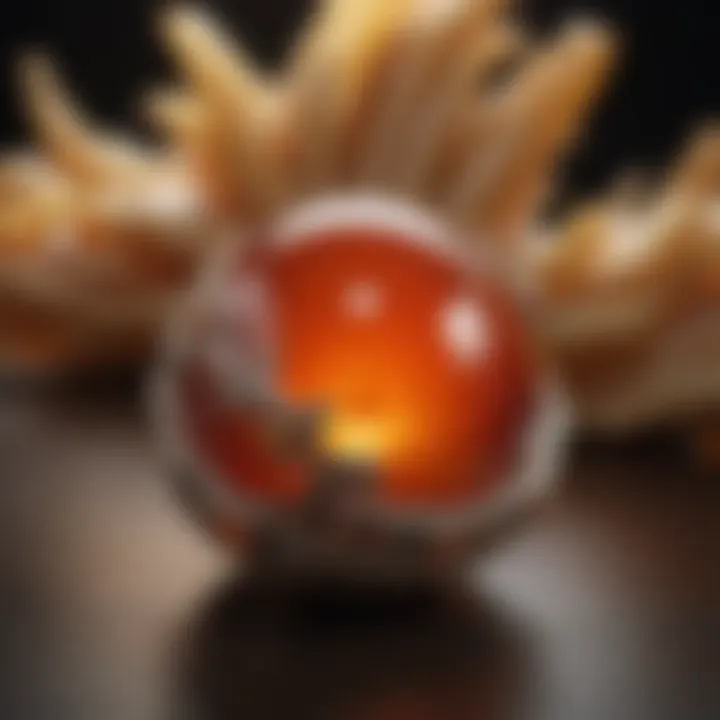The Carnelian Gemstone: A Comprehensive Exploration


Intro
Carnelian, with its warm red to orange hue, has drawn the attention of gem enthusiasts for centuries. It stands out not only for its vibrant color but also for its rich historical significance and utility in various cultural practices. This gemstone provides a fascinating glimpse into both geology and human society, merging natural beauty with centuries of tradition. In this exploration, we will delve into the defining characteristics of carnelian, its physical and chemical properties, and the significant role it has played throughout history.
Gemstone Overview
Definition and Characteristics
Carnelian is a variety of chalcedony, which is a microcrystalline form of silica. It is primarily composed of silicon dioxide. The gemstone is known for its distinctive red to orange coloration, which is attributed to the presence of iron oxide. The color can vary significantly, sometimes appearing nearly transparent. People often value carnelian for its smooth texture and the way it can be polished to a high shine.
Some key characteristics of carnelian include:
- Color Variety: Ranges from pale orange to deep red.
- Transparency: Can be opaque or translucent.
- Hardness: Scores a 6.5 to 7 on the Mohs hardness scale, making it durable for various uses.
Classification of Gemstones
Gemstones are commonly classified based on their rarity, formation, and origin. Carnelian falls within the category of semi-precious stones, distinguished from precious gemstones like diamonds or emeralds. Its classification can also extend to:
- Organic vs. Inorganic: Carnelian is inorganic, as it is formed from mineral processes.
- Primary vs. Secondary Gemstones: Mainly utilized for decorative purposes, carnelian can belong in handmade jewelry or as a collector's item.
Properties of Gemstones
Physical Properties
The physical properties of carnelian greatly contribute to its appeal. Besides the mentioned hardness, other significant physical aspects include:
- Luster: Exhibits a vitreous shine when polished.
- Cleavage and Fracture: Carnelian does not possess distinct cleavage but may fracture in a conchoidal manner.
- Refractive Index: Typically between 1.530 and 1.543, adding to its sparkle.
Chemical Properties
The composition of carnelian extends beyond just silicon dioxide. The presence of iron and aluminum ions affects how light interacts with the gemstone, giving it the characteristic colors. The chemical formula for carnelian can broadly be summarized as:
SiO2 + Fe2O3.
In addition, its durability and resistance to scratching and chemicals make it an ideal choice for both casual and high-end jewelry.
"Carnelian has captivated civilizations for thousands of years, used in amulets and adornments, symbolizing motivation and energy."
Overall, the in-depth understanding of carnelian's properties not only enhances its allure in jewelry but also informs collectors and enthusiasts about its geological significance.
Intro to Carnelian
Carnelian holds a distinct place in the realm of gemstones, noted for both its physical beauty and its rich history. This section aims to illuminate the fundamental characteristics of carnelian, laying the groundwork for understanding its significance in various contexts. Appreciating carnelian is not only about its visual appeal but also understanding how it has been perceived and utilized through history.
The importance of this introduction lies in its ability to provide a clear definition and context for carnelian, an essential precursor to delving into its geological origins, physical properties, and cultural relevance. By summarizing key attributes and historical usages, readers gain insight into why carnelian is favored by gemstone enthusiasts, collectors, and jewelry designers alike.
Defining Carnelian
Carnelian is a type of chalcedony, which is a cryptocrystalline form of quartz. It is characterized by its warm, reddish-orange hues, caused by the presence of iron oxide. The color can vary from pale orange to deep red, making it a versatile gemstone. Its translucent quality adds to its visual appeal, allowing light to play through its layers.
This stone has been admired since ancient times, not just for its color but also for its workability. Carnelian is durable, ranking around 7 on the Mohs scale of mineral hardness. This makes it suitable for a variety of uses, including jewelry and carvings. It is often polished to enhance its appearance, revealing a smooth, shiny surface that is attractive to wearers and collectors.
Historical Context
The history of carnelian can be traced back thousands of years, with evidence showing its use in ancient civilizations such as Egypt, Mesopotamia, and the Indus Valley. In Egypt, carnelian was associated with the afterlife, commonly found in burial artifacts and amulets meant to provide protection to the deceased in the next life.
In Mesopotamia, craftsmen utilized carnelian for seals, which served both practical and ceremonial purposes. These seals were engraved with intricate designs and used to authenticate documents, showcasing the stone's significance in trade and governance.
Throughout different civilizations, carnelian has been regarded for its purported metaphysical properties. Many believed it brought courage, inspiration, and emotional balance. Its presence in jewelry has allowed it to maintain cultural relevance through the centuries, making carnelian a subject of enduring fascination.
"Carnelian is not merely a stone; it embodies historical narratives and human experiences across diverse cultures."
Understanding these facets of carnelian is crucial as it sets the tone for deeper exploration into its geological origins, physical properties, and the significant role it plays in the world of gemstones today.
Geological Origins
Geological origins refer to the processes and conditions that lead to the formation of carnelian gemstone. This aspect is crucial to our understanding of the gemstone itself. Knowing how a gem is formed can enhance appreciation for its uniqueness and value. Factors such as the specific mineral content, temperature, and time all play a role in creating individual specimens with distinct characteristics.
Formation Processes


Carnelian is primarily composed of silica with high iron content, giving it that distinctive reddish hue. The formation of carnelian typically occurs in sedimentary environments where minerals undergo different processes. One main process involves the deposition of silica in sedimentary rock, often in association with other minerals.
During this formation, there are several key conditions that affect the final appearance of the carnelian:
- Temperature variations: High-temperature conditions can enhance the iron oxidation levels, further intensifying the red color.
- Water presence: The presence of water aids in the leaching process of iron oxide into other minerals, which often leads to striking color variations.
- Time: Over geological periods, the processes of crystallization and sedimentation rearrange the molecules, allowing the distinctive bands and zones within the stone to develop.
These processes ultimately dictate how the gemstones acquire their specific characteristics and colors.
Sources of Carnelian
Carnelian can be found in various parts of the world, each location contributing unique traits to the stones harvested there. The most prominent sources include:
- India: Particularly in the regions of Gujarat, carnelian is often mined and highly valued for its quality.
- Brazil: Known for its vibrant color variations, Brazilian carnelian is popular among jewelers and collectors alike.
- Uruguay: Known for smaller yet high-quality stones often used in intricate jewelry designs.
Each sourcing area not only contributes to the physical aspects but also plays a role in the gem's significance in local cultures. Understanding where carnelian is sourced from provides deeper context into its rarity and potential value in the market.
Physical Properties
The examination of physical properties is pivotal in understanding the carnelian gemstone. These properties not only determine the quality and value of the stone but also its practical applications in various fields, including jewelry making and metaphysical practices. The intricate characteristics of carnelian provide enthusiasts and collectors with insights on how to identify and appreciate this gem.
Color Variations
Carnelian is renowned for its rich color spectrum, ranging from a pale orange to a deep reddish-brown. The variations in color can arise from several factors, including iron oxide content and the presence of impurities during its formation. The hue of carnelian plays a significant role in its appeal and market demand.
- Light Carnelian: This variant exhibits soft, pastel shades of orange, usually preferred for delicate jewelry designs.
- Dark Carnelian: A deeper, more vibrant red-orange color is striking and sought after for statement pieces.
Color intensity is often seen as a direct correlation to the gemstone's value. Collectors should be aware that uniform color across the stone enhances its desirability, while uneven tones may decrease its aesthetic appeal.
Hardness and Durability
The hardness and durability of carnelian should not be overlooked. On the Mohs scale, it ranks between 6.5 and 7, signifying a decent level of hardness. This durability makes carnelian suitable for various types of jewelry, including rings and bracelets that undergo regular wear. An understanding of its physical integrity is essential for both designers and collectors.
Factors contributing to its durability include:
- Resistance to Scratches: Carnelian is less likely to scratch compared to softer gemstones, making it ideal for daily wear.
- Impact Resistance: Its ability to withstand minor impacts is beneficial in jewelry application.
Proper care is still necessary to maintain its beauty over time. Avoid exposure to harsh chemicals and store carnelian pieces away from other jewelry that might cause scratching. Such practices will ensure that the gemstone's visual appeal remains intact, safeguarding its value in the long run.
"The fascination with carnelian extends beyond its appearance; its physical properties contribute significantly to its function and longevity in various applications."
Through analyzing these physical properties, enthusiasts can gain a deeper appreciation for carnelian gemstones, recognizing not only their beauty but also their intrinsic value in both natural and cultural contexts.
Cultural Significance
The cultural significance of carnelian extends far beyond its physical beauty, deeply embedding itself in various societies throughout history. As a gemstone, carnelian has been revered not only for its striking color but also for its perceived mystical properties and roles within cultural practices. Different civilizations have attributed diverse meanings and uses to carnelian, making it a crucial topic of exploration in understanding both past and present societal values.
Ancient Civilizations
In ancient civilizations, such as Egypt, Babylonia, and Persia, carnelian was often seen as a protective stone. Egyptians believed it to be a powerful amulet that safeguarded against negativity and misfortune. Many artifacts, including tomb jewelry and funerary items, were crafted from carnelian, reflecting the gemstone's importance in funerary rituals. This admiration was not limited to protection alone; carnelian also symbolized vitality and life, serving as a reminder of the energy within all beings.
In Babylonian culture, carnelian was associated with the goddess Ishtar, representing love and war. Its beauty was celebrated in various forms of art and jewelry, where it was often carved into seals and talismans used for trade and personal adornment. The gemstone’s unique reddish coloring was interpreted as a connection to fertility and renewal, thus holding special significance in agricultural societies.
Another notable example is in India, where carnelian has historically formed an essential part of Hindu and Buddhist traditions. The stone is mentioned in several ancient texts and is believed to harness cosmic energy, aiding in meditation and spiritual development. The significance placed on carnelian in these cultures illustrates how gems can embody cultural values, spiritual practices, and artistic expression.
Modern Usage
In contemporary society, carnelian maintains its relevance, evolving in its applications without losing its historical roots. Today, carnelian is prominent in the jewelry market, appreciated not only for its aesthetic appeal but also for its deemed metaphysical attributes. Many wear carnelian for its purported ability to boost energy, promote motivation, and enhance creativity. Jewelry designers frequently incorporate carnelian into modern pieces, recognizing its versatility and ability to complement various styles.
Furthermore, carnelian has found a role in the wellness community. Often used in crystal healing practices, it is believed to positively influence emotional balance and alleviate feelings of anxiety or anger. Workshops and courses on crystal healing often include discussions on carnelian, reflecting its adoption into new age practices.
In addition to personal adornment and wellness, carnelian is gaining traction within the realm of sustainable jewelry. As consumers increasingly seek ethically sourced materials, artisans and designers are discovering carnelian as a gemstone that can align with these values. Its growing popularity in sustainably crafted pieces indicates a shift toward more conscientious consumer behavior while appreciating the gemstone's rich history.
In summary, carnelian's cultural significance transcends its physical qualities, embedding itself in diverse historical narratives and modern practices. Its importance in ancient civilizations lays a foundation that continues to inspire individual meaning in contemporary use. The gemstone bridges the past and present, offering a rich tapestry of meanings, uses, and applications that resonate with people across cultures and ages.
Metaphysical Properties
The metaphysical properties of carnelian have long fascinated enthusiasts and seekers alike. This gemstone is believed to carry attributes that can enhance various aspects of life, embarking its users on a journey of self-discovery and empowerment. It is essential to explore these properties in detail to understand their significance in both spiritual and practical realms.
Healing Attributes


Carnelian is often associated with a spectrum of healing attributes. Many practitioners of crystal healing advocate for its use in promoting physical vitality and emotional stability. Some of the key healing attributes attributed to carnelian include:
- Energy Booster: Many believe that carnelian invigorates the mind and body. It may enhance motivation and endurance, making it particularly useful for those who feel lethargic or uninspired.
- Boosts Immunity: There are claims that this stone can also help in supporting the immune system. While not scientifically supported, it remains popular among metaphysical practitioners.
- Facilitates Circulation: Some enthusiasts suggest that carnelian has properties that can help improve blood flow. This could lead to better oxygenation of the body’s cells and overall vitality.
When using carnelian for healing, it is advised to carry it in your pocket or wear it as jewelry. Close contact is believed to amplify its benefits, allowing the stone to interact more effectively with one’s energy levels.
Emotional Balance
Emotional balance is a cornerstone of carnelian's metaphysical reputation. Beyond physical attributes, the gemstone is often utilized to achieve a healthier emotional state. The calming warmth of carnelian is thought to help individuals navigate through tumultuous emotions.
Several aspects highlight the potential of carnelian in maintaining emotional balance:
- Dissolving Fear: Users often report feeling less fearful and more secure when carrying or wearing carnelian. This could help combat anxiety and self-doubt, creating a space for positive thoughts to flourish.
- Encourages Motivation: Carnelian is also believed to stimulate creativity and encourage action. People may feel a surge of inspiration, leading them to take necessary steps toward their goals.
- Fostering Forgiveness: Some users find that carnelian promotes emotional healing and forgiveness. Letting go of past grudges can open avenues for new relationships and personal growth.
"Finding emotional balance through carnelian can pave the way for a fulfilling life, filled with possibilities."
In summary, the metaphysical properties of carnelian reflect its potential in various aspects of life. From healing attributes to emotional balance, this gemstone is seen as more than just an aesthetic object; it is a tool for personal development and empowerment.
Identification Techniques
Understanding how to identify carnelian is crucial for both enthusiasts and professionals in the gemstone market. Identification techniques allow individuals to determine the authenticity and quality of the carnelian stones they encounter. Differentiating genuine carnelian from synthetic or imitative stones can significantly impact purchasing decisions and ensure that consumers receive the value expected from their investments.
Visual Examination
A first step in identifying carnelian involves visual examination. Observing the gemstone's appearance can provide immediate clues about its authenticity and quality. Notably, genuine carnelian exhibits a range of rich hues, predominantly red and orange, but may also showcase various shades from brown to even slightly pink. The color saturation might vary in different parts of the stone, exhibiting a natural gradient.
Important elements to consider include:
- Transparency: Authentic carnelian is usually translucent rather than completely transparent. A visual check against light can help evaluate this.
- Surface texture: Genuine stones often display tiny imperfections, like flecks or natural inclusions. These features are often absent in synthetic versions.
- Color zoning: Look for areas of lighter and darker tones within the stone, as these color variations are typical for high-quality carnelian.
The presence of bubbles or scratches might indicate a synthetic stone. In addition to these visual factors, a closer inspection under a jeweler's loupe can reveal details that the naked eye might miss.
Testing Methods
While visual examination provides a foundation, testing methods yield a more definitive assessment of carnelian’s authenticity and quality. Various types of tests can be employed, though some require specific tools and expertise.
Common testing methods include:
- Refractive Index Testing: This method measures how light bends when it enters the stone. Genuine carnelian has a refractive index between 1.54 and 1.55. A refractometer can assist in this measurement.
- Hardness Test: Carnelian falls around 7 on the Mohs scale of mineral hardness. Scratch testing against materials of known hardness could confirm the stone’s durability.
- Acid Test: A small drop of hydrochloric acid can be applied. If fizzing occurs, it suggests that the stone is likely not carnelian, as genuine carnelian is not reactive to acids.
Utilizing these identification techniques effectively empowers both collectors and casual users to make informed decisions regarding the carnelian stones they encounter. By combining visual assessment with practical testing methods, one can confidently ascertain the authenticity and quality of carnelian.
Ethical Sourcing
Ethical sourcing is a vital aspect of gemstone acquisition, including carnelian. It signifies a commitment to acquiring gems in a manner that respects the environment and communities involved in their production. With increasing awareness about the implications of mining and gemstone trading, ethical sourcing has gained significant prominence. This section delves into the key aspects of ethical sourcing in relation to carnelian, focusing on sustainable practices and certification standards.
Sustainable Practices
Sustainable practices in the mining and trading of carnelian are crucial for minimizing environmental impact. These methods often include adopting eco-friendly extraction techniques, which aim to reduce land disruption and pollution. Furthermore, responsible sourcing means ensuring that mining operations prioritize the well-being of local communities. Often, this results in better wages and improved working conditions for miners.
Some important sustainable practices include:
- Land Restoration: After mining, the land should be rehabilitated to its natural state, encouraging biodiversity.
- Water Management: Efficient use of water resources is essential, preventing contamination of local water supplies.
- Fair Trade Initiatives: Supporting local artisans and miners through fair trade practices helps to ensure equitable economic benefits.
These sustainable methods contribute not only to environmental health but also to the social structures in mining regions. The focus shifts from mere profit maximization to a holistic approach ensuring long-term viability.
Certification Standards
Certification standards provide a structured way for consumers to verify the ethical origins of carnelian gemstones. Reputable organizations establish these standards to ensure that gems are sourced responsibly. Certifications can validate that the gemstones meet specific ethical criteria concerning labor practices, environmental impact, and community benefits.
Notable certification standards include:
- Responsible Jewellery Council (RJC): Ensures members adhere to responsible sourcing practices.
- International Gemological Institute (IGI): Offers grading reports that can include details about ethical sourcing.
- Fair Trade Gemstones: Certifies gemstones vetted for ethical mining and trading conditions.
Adhering to such standards enhances transparency in the gemstone market. This not only builds consumer trust but also motivates suppliers to maintain responsible practices in their operations. By supporting certified sources, consumers influence the market positively and advocate for ethical practices globally.
"Ethical sourcing is not just a trend; it is a necessity in today’s interconnected world."
Care and Maintenance


Maintaining the quality and appearance of carnelian gemstones is essential for preserving their allure and value. Proper care ensures that these stones retain their vibrancy and do not suffer from damage over time. When you invest in a piece of carnelian jewelry or a loose stone, understanding how to take care of it can significantly impact its longevity. This section delves into effective cleaning techniques and storage suggestions, crucial for any carnelian enthusiast.
Cleaning Techniques
Recommended Cleaning Solutions
To clean carnelian effectively, it is vital to choose the right solutions. Commonly recommended options include mild soap mixed with warm water, which acts as a safe and gentle way to remove dirt and oils that can accumulate on the gemstone. Another option is to use specialized gemstone cleaning solutions available in the market, specifically designed to clean without causing harm.
The key characteristic of these recommended solutions is their ability to safeguard the integrity of the stone. They avoid harsh chemicals that might scratch or dull the surface. The unique feature of mild soap and warm water is its accessibility and simplicity, making it a practical choice for everyday cleaning. However, users should avoid using ultrasonic cleaners, as they can lead to unexpected damage.
Frequency of Cleaning
Determining how often to clean your carnelian jewelry is another important aspect of care and maintenance. Generally, it is advisable to clean carnelian pieces after wearing them, especially if exposed to perfumes, lotions, or sweat. This practice not only keeps the gemstones shining but also prevents long-term damage.
The beneficial aspect of frequent cleaning lies in the preservation of the stone’s beauty. Regular maintenance can help identify any potential issues early, such as chips or cracks. A unique feature is that this practice promotes mindfulness about the gemstone you own, fostering a deeper connection with it. However, excessive cleaning, especially with harsh chemicals, is something to avoid.
Storage Suggestions
Proper storage plays a significant role in maintaining carnelian gemstones. It is best to store carnelian in a soft cloth bag or a dedicated jewelry box to protect them from scratches. Ensuring they are kept separately from other jewelry is crucial, as carnelian can be susceptible to damage from harder stones.
Also, consider the environmental conditions where you store your carnelian. Avoid placing them in extreme temperatures or areas with high humidity, as this can affect their appearance over time. Ultimately, thoughtful storage helps in prolonging the life of carnelian and preserving its aesthetic and monetary value.
In summary, proper care and maintenance of carnelian gemstones not only enhance their aesthetic appeal but also contribute to their long-term investment value.
By implementing effective cleaning techniques and mindful storage suggestions, owners can ensure that their carnelian remains a cherished part of their collection.
Carnelian in Jewelry
Carnelian has long held significance in the realm of jewelry design. This is not just about aesthetics; the stone carries historical meaning and a sense of connection to the earth. The warming hues of red and orange can be effortlessly combined with various materials and styles. Understanding carnelian's role in jewelry helps collectors, designers, and enthusiasts appreciate its full potential.
Design Trends
Popular Settings
Popular settings for carnelian highlight its striking colors and natural appeal. The most common are sterling silver and gold, which enhance the stone's vibrant appearance. These materials offer durability and resistance to tarnishing. A popular choice among jewelry designers, these settings create stunning contrasts.
Unique features of the popular settings include the ability to showcase carnelian's translucence. This aspect allows light to pass through, adding depth to the gemstone. While carnelian can be set in simpler designs, intricate ones with filigree work are gaining traction. These designs let the stone shine while contributing an artistic flair.
However, some disadvantages exist. Less durable materials such as brass can tarnish and wear out faster. Buyers must consider longevity when selecting pieces.
Combination with Other Gemstones
The combination of carnelian with other gemstones opens up fresh avenues in jewelry design. Pairing carnelian with turquoise or jasper enhances the color palette and adds a unique dimension to each piece. Each stone complements the others to create harmony within the designs.
A key characteristic of these combinations is versatility. They allow designers to explore various styles, ranging from bohemian to modern chic. Carnelian's warm tones can soften the sharpness of cooler stones, creating balance.
However, mixing gemstones demands knowledge of their hardness. For example, soft stones should not be positioned near more durable ones to avoid scratching. It's essential to understand the characteristic of each gemstone for practical and aesthetic purposes.
Market Trends
Market trends indicate a growing appreciation for carnelian in jewelry. The demand for unique pieces that tell a story is rising among consumers. This aligns with the interests of millennial buyers who often seek individuality in their accessories.
Additionally, ethical sourcing is becoming paramount. Consumers increasingly prioritize sustainability over fast fashion. This trend encourages jewelers to source their carnelian responsibly, enhancing the gemstone's value on the market.
Overall, carnelian's popularity in jewelry is evident. From its historic significance to modern design trends, it appeals to a broad range of buyers. As the demand continues to grow, understanding its nuances will become even more essential for anyone in the industry.
Ending
The conclusion of this article is vital as it encapsulates the essence of carnelian and its multi-faceted nature. Carnelian holds a significant position within the realm of gemstones. It is not merely an aesthetic choice but also a stone imbued with historical and cultural weight that spans centuries. Understanding carnelian allows enthusiasts, collectors, and jewelry designers to appreciate its unique properties and the stories intertwined with its existence.
Summary of Key Points
In summary, several important aspects stand out regarding carnelian:
- Geological Origins: This gemstone forms through volcanic activity and subsequent sedimentation, lending it distinct colors and patterns.
- Physical Properties: It boasts a high level of durability (measured 6 to 7 on the Mohs scale), making it suitable for various types of jewelry.
- Cultural Significance: Historically revered by ancient civilizations, carnelian was often utilized in amulets and various ornamental works.
- Metaphysical Properties: Believed to promote healing and emotional balance, it plays a role in modern holistic practices.
- Practical Applications: Its versatility leads to popularity in jewelry design, with trends evolving around unique settings and combinations with other gemstones.
These key points demonstrate that carnelian is more than just a beautiful stone; it embodies a confluence of geology, culture, and metaphysics that enriches its value and significance.
Future of Carnelian in Gemology
As the interest in gemstones continues to grow, carnelian is likely to see an upward trend in both appreciation and demand. Jewelers and collectors are beginning to recognize its aesthetic and historical allure. Moreover, advancements in gemology and sustainable sourcing will play an essential role.
- Sustainable Practices: There is a heightened awareness around ethical sourcing, and sustainable practices are becoming a priority for many buyers. This will enhance the marketability of carnelian, attracting a conscientious demographic.
- New Designs: Designers are exploring creative ways to feature carnelian, blending it with modern aesthetics while honoring traditional significance.
- Increased Research: Continued study into the metaphysical aspects may encourage a broader acceptance of carnelian in wellness and spiritual communities.
Overall, the future of carnelian in gemology appears promising, with increasing knowledge and appreciation leading to richer discussions about its role in both personal expression and the greater cultural tapestry.



